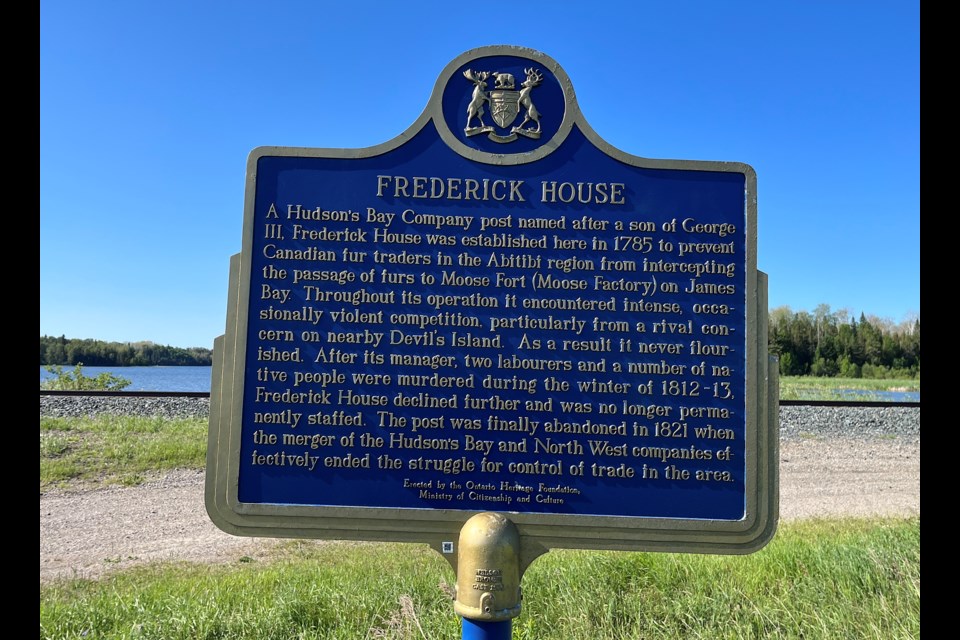Long before mining and forestry were the main industries in Northern Ontario, Europeans treasured another natural resource from the rugged North — fur.
The fur trade was responsible for extensive exploration and mapping across Canada. Traders sought routes to push west through the extensive river system. Posts and forts were early settlements for companies to collect furs and distribute supplies.
One such post was on located on the edge of what would later become the City of Timmins. The Hudson’s Bay Company opened Frederick House, near what is now Barber’s Bay. The post was there from 1784-1821, but was never a really successful operation. According to hand-written journals, supply shortages were frequent. There was also a history of violence at the post in the untamed bush.
According to the Archives of Manitoba, which has an extensive history of the Hudson’s Bay Company, Frederick House functioned as a fur trade post and inland supply station for the Abitibi and Kenogamissi Districts. Read the Frederick House diaries here.
Frederick House, named in honour of King George III’s second son, was established by Philip Turnor in June 1784. Turnor had intended to establish a post on Abitibi Lake, but only made it to the confluence of the Frederick House and Abitibi Rivers, where Frederick House was first built.
In 1785, Turnor abandoned the initial site and moved about 50 miles away to the southeast shore of Lake Waratowaha, later renamed Frederick House Lake. It fell under the administration of the Kenogamissi District.
In 1794, the governor and committee ordered that Frederick House be abandoned since its returns were low. However, it remained open as an inland supply station for Abitibi and Kenogamissi.
The post was difficult to maintain because the Frederick House and Abitibi rivers were both difficult for canoes to navigate.
According to archives from Ontario Heritage Trust, the post was established to prevent Canadian Fur traders in the Abitibi region from intercepting shipments of furs to Moose Factory on James Bay.
Throughout its operation, it encountered intense, occasionally violent, competition, particularly from a rival concern on nearby Devil’s Island. As a result, it never flourished.
In the winter of 1812-13, the post was attacked and three Hudson’s Bay Company staffers — a manager and two labourers — and four Aboriginal people were murdered.
Some accounts say as many as nine Aboriginals were killed, as the suspected murderer spent the winter at the site and killed anyone who came by, fearing they would report him.
Eventually, two men from another post found the post looted and deserted. After the snow melted, 12 bodies were found.
A manhunt was held for the suspect, who was never found.
As a result, Frederick House was closed in the summer of 1813 and not reoccupied, although trade continued in log tents on Frederick House Lake.
From 1815-16, Frederick House operated outposts at Matawagamingue (Matawagummie) and Pishquajaggamie.
After the Hudson’s Bay Company’s amalgamation with the North West Company in 1821, all trade at Frederick House Lake was abandoned.
The post was never rebuilt.
In 1911, during the building of the Ontario Northland Railway, remains of the fort and several shallow graves were discovered.
It is worth noting that the founder of the post has a place in Canadian history.
Turnor was a surveyor and cartographer for the Hudson’s Bay Company. He was hired on for three years as an inland surveyor with the HBC. He is credited with exploring and mapping many of the settlements and their connecting rivers and lakes for the company in the late 18th century.
He was a trader and explorer on the Moose and Albany river systems from 1780-87. Turnor is best known for charting of the route to Athabasca from 1790-92 and as a teacher of the geographers David Thompson and Peter Fidler. Turnor produced the first accurate maps of much of this region of Northern Ontario.
A variety of willow, unique to the sand dunes of Lake Athabasca, is named Turnor’s willow in his honour.
He returned to his native London, England, in 1792. There is a historic plaque in his honour located in Moose Factory.
There is a heritage plaque for the Frederick House post today in Connaught, just a stone’s throw away from the railway tracks.
